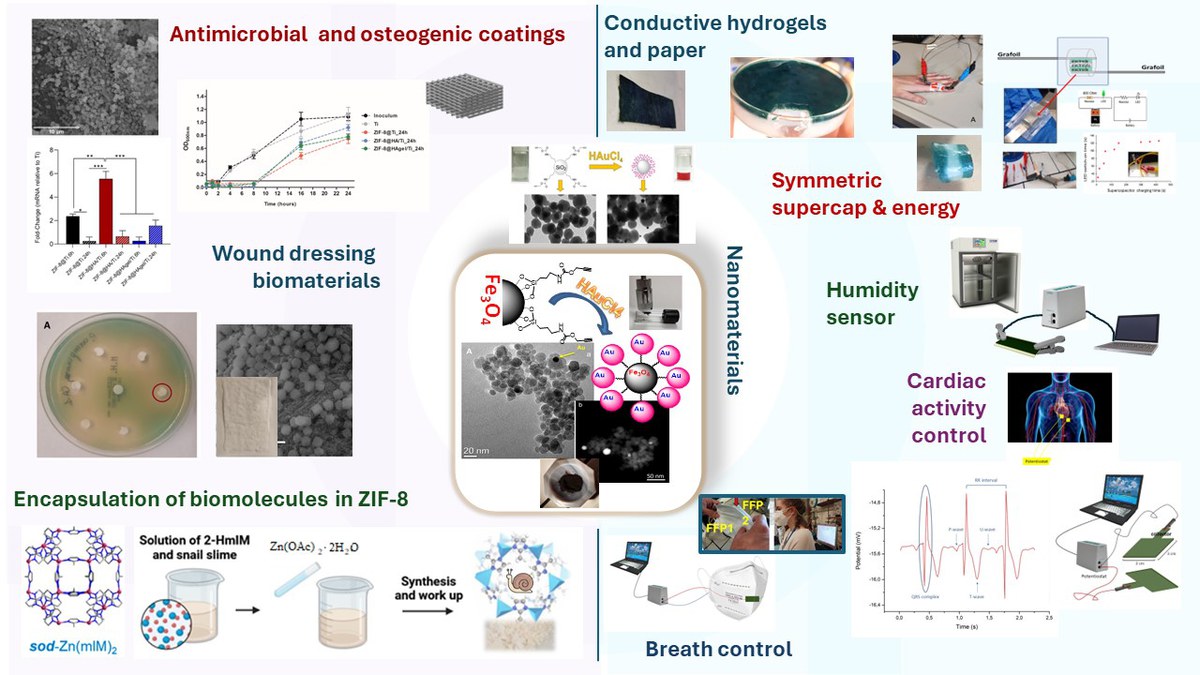The overall research activity of the CHINANOR GROUP regards:
- the preparation of nanomaterials with a focus on the synthesis and characterization of metal or metal oxide nanoparticles supported on several functionalized substrates (polycarbonate membranes, silica, alumina, titania, magnetite, hydroxyapatite) and their applications in heterogeneous catalysis and biomedical field;
- development of composite systems for applications in the energy and sensor sectors. This line of research aims at the synthesis and electrosynthesis of conductive composite materials based on cellulose fibers (conductive paper) or hydrogel. The objective is to build low-cost, low-environmental-impact systems that can be used as "single-use systems", capable of providing "output" signals in response to specific "input" signals. These systems can be applied in the sensor sector for applications in the environmental (humidity sensors), energy (pseudocapacitors), electronic (touch screen, TENG), or biomedical (wound healing) fields. The material conductivity is guaranteed by the presence of conductive polymers or metal oxides while cellulose fibers or synthetic polymers (e.g. polyvinyl alcohol) are used as support material depending on whether you want to prepare conductive paper or hydrogels;
- the chemical (wet chemical synthesis and solvothermal synthesis in stainless-steel digestion bombs, sonochemical synthesis with SONOPLUS Ultrasonic homogeniser) and electrochemical synthesis of Metal–Organic Frameworks (MOFs), a class of crystalline materials constructed from organic linkers and inorganic nodes that possess ultra-high surface areas and pore volumes. Ideal candidates for biomedical, energetic and sensor applications.
Instrumental techniques routinely employed: GC-MS, AAS, ICP-AES, FTIR, UV-Vis spectroscopy, ESI-MS, DLS, multinuclear NMR spectroscopy, XRD, SEM and TEM microscopy. In addition, the classic electrochemical techniques (cyclic voltammetry, chronoamperometry), impedance spectroscopy, spectroelectrochemical techniques and 4-point conductivity measurements are used to characterize the new materials and to investigate their behaviour.
Group members and most recent publications:
-Prof. Barbara Ballarin (https://www.unibo.it/sitoweb/barbara.ballarin)
-Prof. Maria Cristina Cassani (https://www.unibo.it/sitoweb/maria.cassani/)
-Valentina di Matteo (PhD student, valentina.dimatteo5@unibo.it)
-Lamyea Yeasmin (PhD student, yeasmin.lamyea@unibo.it)
-Tsegaye Adane Birhan (PhD student, tsegayeadane.birhan2@unibo.it)
- M. C. Cassani, F. Bonvicini, M. F. Di Filippo, B. Ballarin, Silvia Panzavolta, V. Di Matteo, “Encapsulation of Snail Slime in Metal–Organic Framework ZIF-8”, J. Funct. Biomater. 2025, 16, 443. https://doi.org/10.3390/ jfb16120443
- E. Balliana, M. Marchand, V. Di Matteo, B. Ballarin, M.C. Cassani, S. Panzavolta, E. Zendri, “Application of Zinc-Based Metal-Organic Framework ZIF-8 on Paper: A Pilot Study on Visual Appearance and Effectiveness”, Polymers 2025, 17, 1369. https://doi.org/10.3390/polym17101369
- G. D’Altri, A. Giovagnoli, V. Di Matteo, L. Yeasmin, S. Scurti, I. Gualandi, M. C. Cassani, S. Panzavolta, M. Rea, D. Caretti, B. Ballarin, "The Influence of DMSO on PVA/PVDF Hydrogel Properties: From Materials to Sensors Applications”, Gels 2025, 11, 133. https://doi.org/10.3390/gels11020133
- V. Di Matteo, M.F. Di Filippo, B. Ballarin, F. Bonvicini, M.R. Iaquinta, S. Panzavolta, E. Mazzoni, M.C. Cassani, "Porous titanium scaffolds modified with zeolitic imidazolate framework (ZIF-8) with enhanced osteogenic acitivity for the prevention of implant-associated infections", Front. Chem. 2024, 12:1452670. doi: 10.3389/fchem.2024.1452670.
- A. Giovagnoli, G. D’Altri, L. Yeasmin, V. Di Matteo, S. Scurti, M.F. Di Filippo, I. Gualandi, M.C. Cassani, D. Caretti, S. Panzavolta, M.L. Focarete, M. Rea, B. Ballarin, “Multi-Layer PVA-PANI Conductive Hydrogel for Symmetrical Supercapacitors: Preparation and Characterization”, Gels 2024, 10, 458. https://doi.org/10.3390/gels10070458
- G. D’Altri, L. Yeasmin, V. Di Matteo, S. Scurti, A. Giovagnoli, M.F. Di Filippo, I. Gualandi, M.C. Cassani, D. Caretti, S. Panzavolta, E. Scavetta, M. Rea, B. Ballarin, “Preparation and Characterization of Self-Healing PVA−H2SO4 Hydrogel for Flexible Energy Storage”, ACS Omega 2024, 9, 6391; https://doi.org/10.1021/acsomega.3c05392
- Di Matteo, M.F. Di Filippo, B. Ballarin, G.A. Gentilomi, F. Bonvicini, S. Panzavolta, M.C. Cassani, "Cellulose/Zeolitic Imidazolate Framework (ZIF-8) Composites with Antibacterial Properties for the Management of Wound Infections”, J. Funct. Biomater., 2023,14, 472; https://doi.org/10.3390/jfb14090472
- I. Ragazzini, I. Gualandi, G. D’Altri, V. Di Matteo, L. Yeasmin, M.C. Cassani, E. Scavetta, E. Bernardi, B. Ballarin, “Polyaniline/poly-(2-acrylamido-2-methyl-1-propanesulfonic acid) modified cellulose as promising material for sensor design”, Carbohydrate Polymers, 2023, 316, 121079; https://doi.org/10.1016/j.carbpol.2023.121079
- I. Ragazzini, R. Castagnoli, I. Gualandi, M.C. Cassani, D. Nanni, F. Gambassi, E. Scavetta, E. Bernardi, B. Ballarin, “A resistive sensor for humidity detection based on cellulose/polyaniline”, RSC Adv., 2022, 12, 28217; DOI: 10.1039/d2ra03982f
-
G. Pagot, M.C. Cassani, F. Gambassi, B. Ballarin, D. Nanni, M. Coi, D. Barreca, E. Boanini, Vito Di Noto, “Propargyl carbamate-functionalized Cu(II)-metal organic framework after reaction with chloroauric acid: An x-ray photoelectron spectroscopy data record”, Surf. Sci. Spectra, 2022, 29, 024007; https://doi.org/10.1116/6.0001950
-
Ragazzini, I. Gualandi, S. Selli, C. Polizzi, M.C. Cassani, D. Nanni, F. Gambassi, F. Tarterini, D. Tonelli, E. Scavetta, B. Ballarin, “A simple and industrially scalable method for making a PANI-modified cellulose touch sensor”, Carbohydrate Polymers, 2021, 254, 117304.
-
M.C. Cassani, F. Gambassi, B. Ballarin, D. Nanni, I. Ragazzini, D. Barreca, C. Maccato, A. Guagliardi, N. Masciocchi, A. Kovtun, K. Rubinig, E. Boanini “A Cu(II)-MOF based on a propargyl carbamate-functionalized isophthalate ligand”, RSC Adv., 2021, 11, 20429.
-
M.C. Cassani, R. Castagnoli, F. Gambassi, D. Nanni, I. Ragazzini, N. Masciocchi, E. Boanini and B. Ballarin, “A Cu(II)-MOF based on a propargyl carbamate-functionalized isophthalate ligand as nitrite electrochemical sensors”, Sensors, 2021, 21, 4922.
